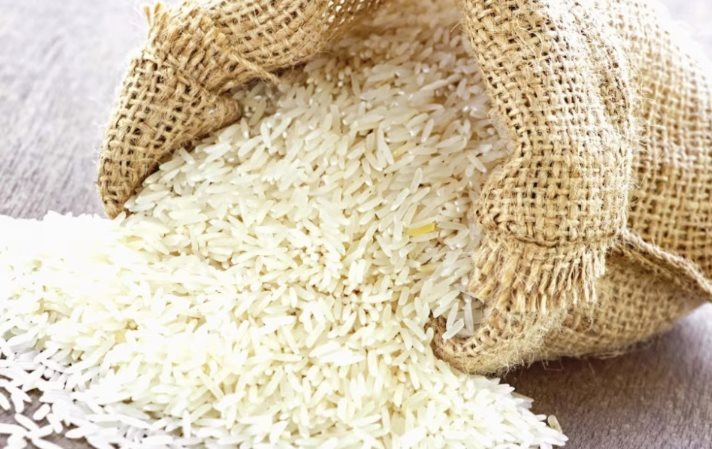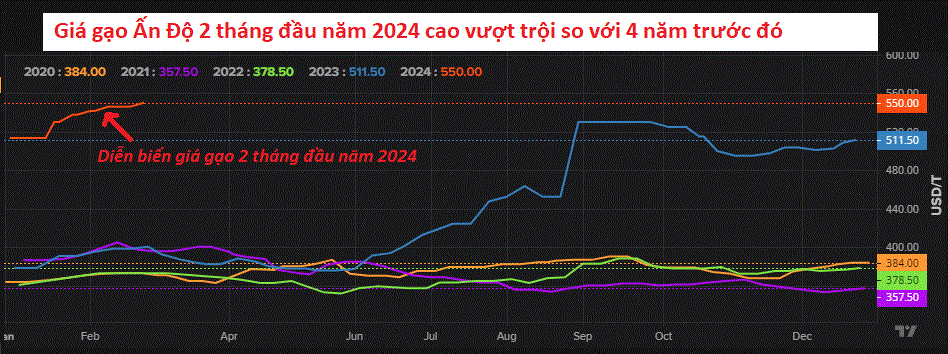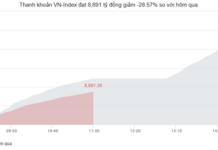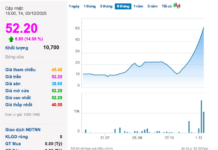
According to the world’s largest rice exporter, India extended the export tax of 20% on rice on February 21, 2024, for an indefinite period (expected until March 31, 2024) to prevent any potential price increase in the domestic market before the general election.
India’s food inflation rate in January 2024 was 8.3%. With only a few months left until the election day, the government of Prime Minister Narendra Modi is concerned about the high food prices, which account for about half of the country’s consumer basket.
The concerns of the Indian government are not unfounded. With tight supply conditions and improving demand, Indian rice prices have reached a new record high this week, with 5% broken rice priced at $546-554 per ton, up from $542-550 per ton last week. Despite the sharp increase in Indian rice prices, many customers still choose to buy it because even though it has increased, Indian rice is still cheaper than other origins, with Thai rice priced at $615 per ton, while Vietnamese rice is priced at $625-630 per ton.

The tension in the global rice market, which started when India restricted rice exports, seems far from over, as rice prices in many important importing markets continue to rise despite their growing inventories.
According to data from the Philippine Statistics Authority (PSA), the price of rice in the market in January 2024 increased sharply despite the increase in stockpiles. The average wholesale price of regular milled rice in January 2024 was 46.60 pesos per kilogram, up 1.7% from 45.83 pesos per kilogram in December. Compared to the same period last year, this price is 32.7% higher, with an average price of 35.11 pesos per kilogram in January 2023. Similarly, the average wholesale price of well-milled rice increased by 1.5% to 49.96 pesos per kilogram and was 28.6% higher than the 38.28 pesos per kilogram in January 2023.
The country’s rice reserves have increased by 6.9% as of January 1, 2024, reaching 2.03 million tons, up 9.6% from the same period last year, when reserves were 1.85 million tons. Nearly half of the rice reserves are held by households or farmers, with household reserves totaling 1 million tons and commercial rice reserves held by traders and importers at 978,000 tons.
Indonesia has also been actively importing rice since last year and shows no signs of slowing down. In 2024, the Indonesian National Food Agency (Bulog) was allocated a quota of 2 million tons of rice, but due to the large harvest in March and April being delayed by 2 months, the government decided to import 1.6 million tons of rice as a precautionary measure for immediate use.
Earlier, on January 29, the Indonesian National Food Agency (Bulog) opened a tender to purchase 500,000 tons of 5% broken rice, of which Vietnamese companies won about 351,100 tons.
Bangladesh also reduced import duties on rice from 63% to 15% earlier this month and may import 500,000 tons of rice in 2023/24 to cool down domestic rice prices, which have been continuously rising despite recent high domestic rice yields.
The current rice fever in the world market, in addition to India’s upcoming elections, is deeply rooted in weather factors, as concerns about adverse weather conditions and drought caused by El Niño threaten the 2023-2024 crop yields in Asia and. Specifically, the drier conditions caused by the expected cyclical climatic phenomenon are expected to have a serious impact on the rice crop.
Many crops, especially water-dependent crops, are heavily affected by El Niño. This phenomenon has a significant impact on the global rice supply, not only affecting Southeast Asia but the whole world.
For example, the Thai government recently confirmed that rice production will decrease by about 6% in the 2023-24 crop year due to drought. Meanwhile, S&P Global Commodity Insights also noted that rice production has decreased in India’s Kharif 2023-24 season due to drought conditions caused by the El Niño weather phenomenon and delayed rabi sowing.
The US Department of Agriculture’s market-watching attaché has forecasted India’s total rice production to reach 128 million tons in marketing year 2023-24 (October to September), down from 135.5 million tons in the previous crop year.
In fact, the decrease in India’s rice exports can be partially offset by increased exports from other major rice producers. For example, recent reports have noted increased exports from Vietnam – the world’s third-largest exporter and fifth-largest producer – following India’s restrictions to meet the growing demand of importing countries.
According to Vietnam’s customs data, Vietnam exported $4.6 billion worth of rice last year, up more than 35% from 2022. Vietnam’s rice production in 2023 is also expected to increase by 1-2% compared to 2022, reaching over 43 million tons.
In 2024, at the beginning of the year, Vietnam’s rice exports have increased significantly. Specifically, in January 2024, the country exported 512,265 tons of rice, equivalent to $362.26 million, at an average price of $707.2 per ton, up 4% in volume, 7% in value, and 2.8% in price compared to December 2023, according to statistics from the General Department of Customs.
Compared to the same period last year, rice exports in January 2024 increased sharply by 42.6% in volume, 94.1% in value, and 36.2% in price.
However, with India accounting for 40% of global rice exports, the country’s near complete restriction on rice exports tilts the global supply and demand balance towards scarcity.
The World Bank predicts that rice prices will further increase by 6% in 2024, due to “the threat from El Niño, policy reactions from major rice exporters and importers, and the geographic and market concentration of rice production and exports.”
According to the United Nations (UN), in 2024, El Niño “will affect rainfall in many Asian countries, causing severe droughts or floods and thereby affecting agricultural production,” and such shocks are expected to be “far more severe in countries with agriculture” which accounts for the highest proportion of GDP.
Reference: International Banker



































